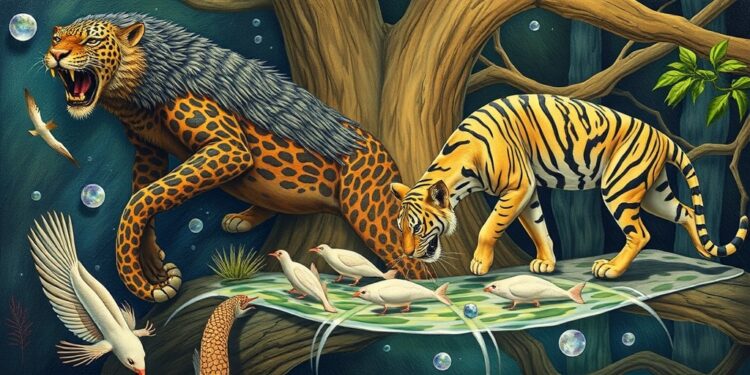The animal kingdom is a realm where intricate relationships and unexpected interactions unfold, shedding light on the complex tapestry of cooperation found among diverse species. Throughout the natural world, examples abound of species coming together for mutual benefit, exemplifying a type of collaboration that challenges our understanding of intelligence and cooperative behavior. These relationships vary significantly, from the cleaner wrasse fish that help maintain the health of their larger, often predatory hosts to the remarkable partnerships formed between octopuses and reef fish during hunting expeditions.
In a groundbreaking study, biologists Eduardo Sampaio from the Cluster of Excellence “Collective Behaviour” at the University of Konstanz and his colleagues Alexandra Schnell and Piero Amodio raise compelling questions about the cognitive underpinnings that facilitate such alliances between species. This research aims to decode the mechanisms of perception, learning, and decision-making that empower animals to collaborate across species lines. The findings are laid out in an article published in Current Biology, offering a glimpse into the cognitive foundations of cross-species social behavior.
The partnership between octopuses and reef fish serves as the focal point of this research. By hunting together, these usually solitary creatures are able to exploit their unique strengths and enhance their chances of securing food. The octopus displays intelligence by interpreting the signals sent by fish, which identify hiding spots of potential prey. This synergy illustrates a remarkable level of communication and problem-solving that extends beyond the confines of their own species, highlighting the evolving complexity of social structures in the animal kingdom.
These partnerships challenge traditional views on animal intelligence, which have often been confined to interactions within species. From an evolutionary perspective, the necessity of collaboration across species boundaries has played a significant role in shaping social behaviors and cognitive abilities. The study argues that intelligence is not just a solitary evolution; it emerges from the social landscapes in which these creatures interact. Understanding these interactions may rewrite the narrative of intelligence in the animal kingdom, showcasing a dynamic model of cooperation.
Through observations of these interactions, researchers have documented a range of cooperative behaviors that beg further investigation. For instance, fish are known to guide octopuses to prey hiding places while also benefiting by sharing in the catch. This behavior not only signifies an impressive level of cognitive functioning but also indicates a mutual understanding of cooperative reward—a cornerstone of successful social interaction.
Moreover, the implications of these findings extend to conservation and management strategies. By understanding the cognitive processes that facilitate these alliances, we can better protect the ecosystems in which such cooperative behaviors thrive. It opens up avenues for greater respect towards the complexities of interspecies relationships, suggesting that conservation efforts should foster environments where such interactions can flourish.
In addition to octopuses and reef fish, the study highlights other notable examples of cross-species collaboration in the animal kingdom. Cleaner wrasses, for instance, engage in a symbiotic relationship with larger fish, providing essential parasite removal services in exchange for food. Similarly, honeyguide birds demonstrate incredible adaptability by leading humans to bee hives, capitalizing on this relationship to feed opportunistically. These behaviors illustrate a spectrum of cooperation that can only be understood through an interdisciplinary lens, merging findings from biology, psychology, and environmental science.
Researchers involved in the study, several of whom are recognized as National Geographic Explorers, emphasize the importance of a holistic approach to understanding animal behavior. By drawing on comparative psychology and observations in natural settings, the research sheds light on the cognitive factors that underpin social cooperation in the wild. Such interdisciplinary collaborations are vital not only for advancing academic knowledge but also for inspiring the public’s interest in biodiversity and the natural world.
As the research continues to unfold, it offers profound insights into the nature of consciousness and sentience in animals. The partnership dynamics observed between species challenge the anthropocentric viewpoint that is prevalent in traditional studies of animal behavior. By acknowledging and exploring these interspecies alliances, we can gain a richer understanding of the evolution of intelligence and social complexity.
With the increasing importance of recognizing the interconnectedness of eco-systems, studies like these underscore the necessity for a change in our approach to wildlife conservation and management. Incorporating knowledge about cognitive processes in animals can enhance conservation strategies, allowing for more holistic and effective interventions aimed at preserving not only individual species but also the intricate relationships that sustain ecological balance.
In conclusion, exploring cross-species cooperation reveals a sophisticated world of communication, intelligence, and social interaction that transcends previous boundaries of understanding. The partnerships that define the dynamics of the animal kingdom emerge as crucial elements in shaping evolutionary success, driving home the importance of collaboration in nature. As this research continues, it holds promise for enriching our understanding of animal cognition and the wondrous complexity of life that flourishes on our planet today.
—
Subject of Research: Cognitive foundations of cross-species cooperation
Article Title: Cognition in multi-species sociality
News Publication Date: 2025
Web References: https://www.campus.uni-konstanz.de/en/science/alliances-among-animals
References: E. Sampaio, A.K. Schnell, P. Amodio (2025) Cognition in multi-species sociality. Current Biology; doi: 10.1016/j.cub.2025.01.012
Image Credits: Eduardo Sampaio, Robert Delfs, Simon Gingins, Dominic Cram, Bernard Gagnon/Wikimedia Commons
Keywords: Animal behavior, cooperation, cognitive science, evolution, biodiversity
Tags: animal cooperation strategiesbiologist research on animal alliancescleaner wrasse mutualismcognitive behavior in animalscognitive mechanisms in animal collaborationcollective behavior in the animal kingdomcross-species partnerships in natureecological interactions among speciesevolutionary advantages of cooperationmutual benefit in animal relationshipsoctopus reef fish collaborationsocial behavior across species





